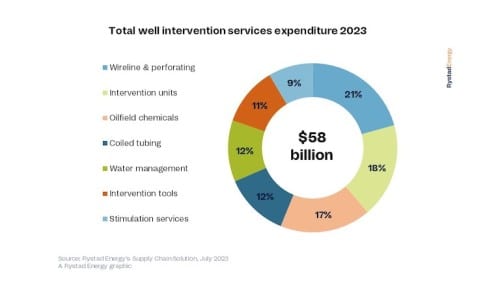Oil And Gas Well Intervention Spending Set To Skyrocket
As oil and gas production companies look for efficient and cost-effective methods of increasing their output. With that, the well-intervention market is set to get a healthy boost. Spending on interventions is a way to extract additional resources from an existing well. This is instead of drilling a new one. The projection is for it to jump by almost 20% this year and total $58 billion. Rystad Energy’s modeling shows this is just the start of a surge in the coming years. It is as the focus on efficiency intensifies.
The intervention rate
How many oil and gas wells go through the intervention process? The forecast is that it will reach 17% in 2027. This would total about 260,000 wells globally.
More than $11 billion of the total expenditure will be directed to the wireline & perforating segment. Intervention units and oilfield chemicals sectors will represent 35%. In addition, the sum of the investments in coiled tubing, water management, and intervention tools is expected to close in 2023 surpassing $20 billion.
To boost production rather than drill new wells, operators are more likely to undertake intervention into mature assets that have been producing for more than five years, with relatively high production rates which are starting to show signs of decline. Onshore interventions in Asia, South America, and Africa will lead the 9% growth in activities related to intervention during 2024, a year expected to be significant for the good intervention market. North America is projected to account for 64% of the total oil and gas wells ready for intervention in 2027, whereas Asia and South America will reach their maximum in 2026, with respectively 41,413 and 9,703 wells.
Click here to read the full article
Source: Markets Insider
If you have further questions about the topic of Oil And Gas Well Intervention, feel free to contact us here.




Leave a Reply
Want to join the discussion?Feel free to contribute!